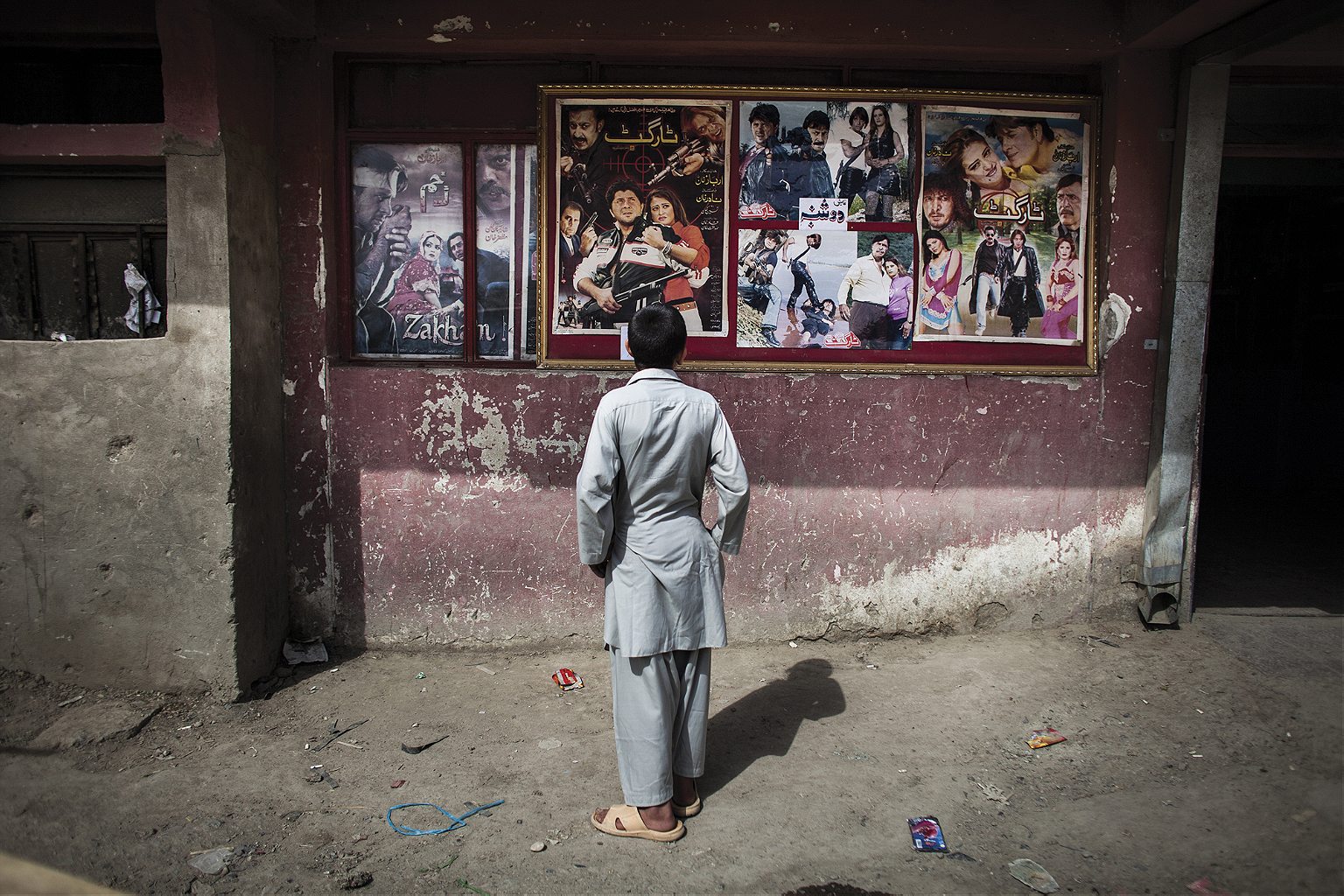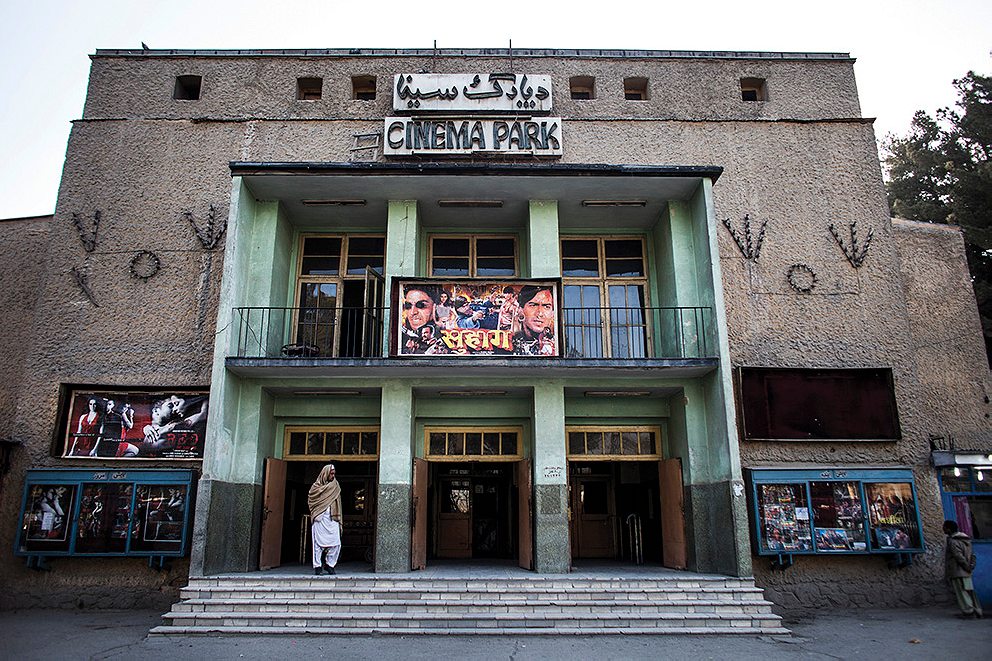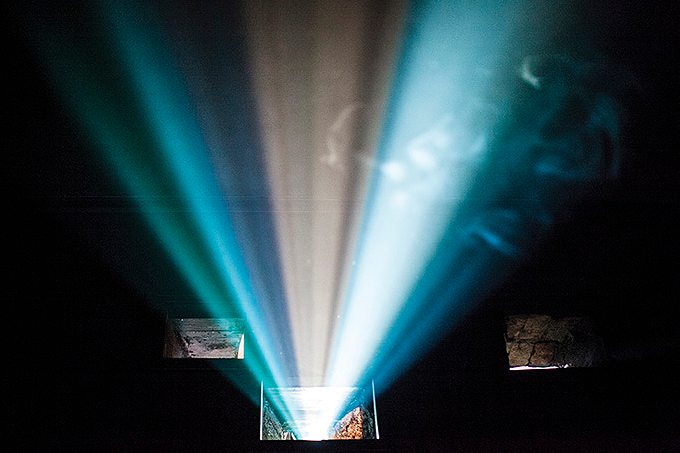Photographer Jonathan Saruk explores the world of Kabul’s cinemas in his upcoming book.
After years of covering conflict in Afghanistan, Jonathan Saruk came across the smoke-filled movie theaters of Kabul, where the harsh realities of daily life can be forgotten for a few hours. Seduced by the beauty of the rundown buildings, many of which had been damaged during the civil war, the photographer started documenting what goes on in the darkness of Afghan theaters. Three years later, he’s raising funds to publish his first book, “The Forbidden Reel: A Journey Through the Cinemas of Kabul.”
Roads & Kingdoms: When did you live in Afghanistan?
Jonathan Saruk: I moved there in October 2008 and stayed through June the next year. At the time, Afghanistan was the big story of the day, and so like many photographers fresh out of school, I wanted to get right in there, so I had set up several embeds with the military during the first few months I was there. Since then, I have returned over a half a dozen times, usually for a month or so.
R&K: You were attracted to the country because you wanted to cover conflict?
JS: Yes, initially. Since college I have always wanted to cover hard news and be in the thick of it. But after being embedded for several months, my attention began to be pulled towards the more daily life types of stories. While that transition had been building in my head for a while, the trigger so to speak was actually when I shifted to a different photo agency and it became a lot more difficult for me to apply for an embed. It ended up being fortuitous as I rather quickly began stumbling upon interesting stories in and around Kabul that I found equally satisfying and important to cover. Being embedded in a sense is quite easy, especially as a freelancer. The story is always right in front of you, you sleep there, they feed you, you move around with them, and it doesn’t cost anything. Obviously it was dangerous at times and hard work physically, but if you get up every morning and push yourself, you usually get something interesting to file. Back in Kabul, I had a lot more freedom. I would meet with my fixer and we would go out and find stories. It was great to be able to just walk around, interact with Afghans without body armor on and just take my time and find some inspiration. At the same time, it was also much more stressful and there was a lot of competition.
R&K: I can imagine. Who did you embed with?
JS: The US and the French. The Americans had the least amount of restrictions in terms of engaging the public and the enemy. The French were much more careful and wary of doing something risky.
The situations were often stressful when the military was around
R&K: And what was your relationship with the soldiers like?
JS: Unfortunately I only took French for two semesters in college, so it was much easier to communicate and get along with the American soldiers. I also spent a lot more time with the Americans—I only did one embed with the French and I was thrown out after only a week.
R&K: You were thrown out?
JS: Kind of a long story, but in short, while at a forward operating base in Kapisa called Tagab, there was a massive fire. It destroyed a dozen vehicles, killed an Afghan employee, but it made for amazing pictures, obviously. So I took a few shots and filed them. I didn’t break any rules according to my contract, but the pictures made their way to the desk of Paris Match and to put it mildly, the Colonel on the base was not happy.
R&K: Wow. So even though embedding brings some facility, it also has a lot of constraints…
JS: Absolutely. The biggest restraint is when photographing the dead and wounded. Technically you are supposed to have written permission, which is of course hard to get after the fact. So unless you get everyone to sign a waiver at the beginning, you are technically not allowed to photograph them if something happens.


strong>R&K: How did your relationship with locals change when you stopped being embedded… Earlier, you used the term “enemy”…
JS: Yes, I should clarify that this is how the military spoke about the insurgents fighting NATO and Afghan government forces. Obviously, when you meet someone with a bunch of guys standing around with big guns, they are going to treat you a bit differently than if they meet you alone. The situations were often stressful when the military was around and there was very little time to hang around and get to know anyone, except the soldiers. Being in Kabul and meeting Afghans there was a completely different experience. It’s the cosmopolitan center of the country, unlike many of the rural areas where the military is focused, so I could interact with all walks of life, from the Western-educated Afghans working at NGOs and starting their own businesses to the working poor. This was impossible while embedded.
R&K: So is that when you went into your first cinema?
JS: The idea came soon after finishing my last embed in Wardak. I had heard about a bodybuilding contest and I wanted to go check it out. It took place at Cinema Park in Shahr-e-naw park in the center of Kabul. I had seen the building many times before, but never thought much of it. After spending the day there though I became really curious to see what it was like as an operating theater. I didn’t get a chance to go back, but a year and a half later I was back in Kabul and decided to check it out, and that’s how it started.
R&K: What is the atmosphere like in an Afghan cinema? Is it a different experience from here in the West?
JS: The buildings are run down, it’s dark, it doesn’t smell very nice, paint is chipping off the walls and a lot of things are broken. It’s like they sat there for 20 years, nobody took care of them and then they started working again, so they fixed everything up with duct tape and whatever they could find. The crowd is all men, mostly unemployed or kids who aren’t in school when they should be. People are smoking cigarettes and chatting on their phones, yelling across the room to each other sometimes, and a lot of these movies have long dance sequences so occasionally you see people get up on stage and dance under the screen. What’s interesting is that a lot of the young men there, especially ones that come from more conservative families, don’t interact with women too much. Going to the movies and seeing these women with very little clothing sometimes gyrating across the screen, it’s quite an experience for them.
R&K: What were the most popular movies?
JS: Pakistani movies. During the civil war and the Taliban, a lot of Afghans fled to Pakistan so many can understand a bit of Urdu. That’s what you see posters for: Pakistani and Indian films. Occasionally you would see an American film playing, and even more rarely an Afghan film. There’s a burgeoning DVD market so some people in Kabul go out with a camera and a couple of actors and make low-budget films in Dari or Pashto. Those are quite popular, you see them all over the market, but very few of them actually make it to the movie theater.

strong>R&K: I imagine there were a lot of challenges to shooting inside a cinema…
JS: Yes, it was super dark and trying to take somebody’s picture while they’re watching a movie… You can imagine, not everybody was always too thrilled about that. It took a lot of time and patience to find the right approach, and technically speaking, trying to get the camera to hold still long enough so I could get a decent exposure. I didn’t actually interact with people while the movie was going, but I did however spend a lot of time in projection rooms talking to the people who worked there through my fixer. It was always interesting to see their perspective. A lot of them were father-and-son run businesses.
R&K: Why do you think it’s a male-dominated activity?
JS: Every time we went to the theater, we would ask this question. You see this a lot in Afghan society, there are very few women in public places—for entertainment purposes at least. We heard excuses like “women don’t think it’s safe, they think suicide bombers will come bomb up the movie theatre…” I think to a certain extent, maybe they don’t feel safe, but I don’t think it’s because of suicide bombers. I can’t imagine an Afghan woman being comfortable sitting in a dark room with hundreds of men. It’s just culturally not acceptable and I think that’s one of the reasons why. Apparently though, the Afghan who wrote the introduction to my book told me that a newer theater had opened up in an upscale mall and apparently women are going to this one. So it’s getting better.
R&K: Do you think Afghans go to the cinema for the same reasons that Westerners do?
JS: I think so. I think the stresses of life in Kabul are more extreme than in the West or Europe, but yes, not having to think about anything, just focusing on what’s in front of you on the screen, that’s what they’re seeking as well. Whether you’re unemployed or just trying to take a breather for an hour and a half, I think it is that sense of escape. To really get away from the craziness outside.
You can help Jonathan Saruk publish “The Forbidden Reel: A Journey Through the Cinemas of Kabul” by donating to his Kickstarter campaign.